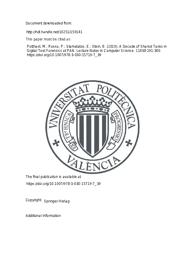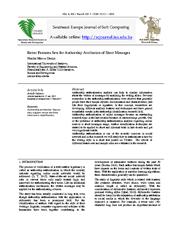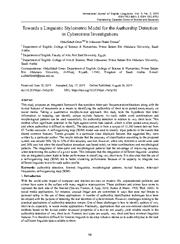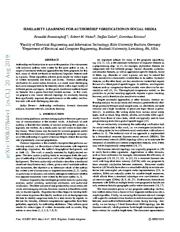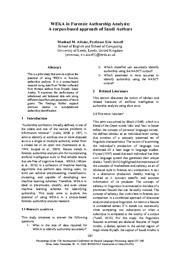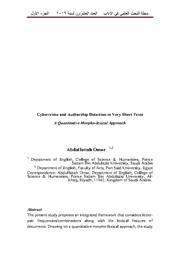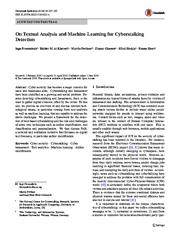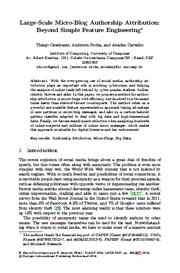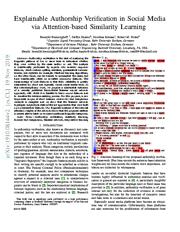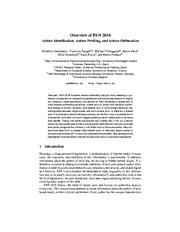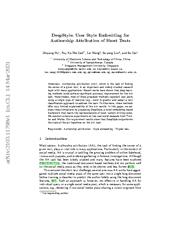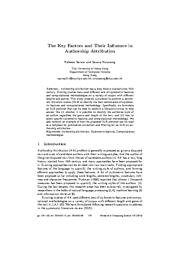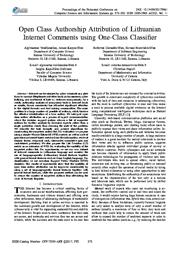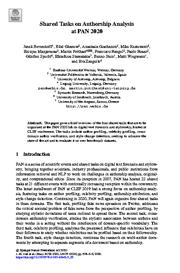A copy of this work was available on the public web and has been preserved in the Wayback Machine. The capture dates from 2021; you can also visit the original URL.
The file type is application/pdf.
Filters
A Decade of Shared Tasks in Digital Text Forensics at PAN
[chapter]
2019
Lecture Notes in Computer Science
We also briefly introduce the upcoming PAN 2019 shared tasks. 1 The acronym originates from the title of the first PAN workshop held at SIGIR-2007: Plagiarism analysis, Authorship identification, and Near-duplicate ...
PAN is a series of shared tasks that started in 2009 and significantly contributed to attract the attention of the research community in well-defined digital text forensics tasks. ...
This is crucial in applications of cybersecurity, digital humanities, and social media analytics. Writing style, rather than topic information, is the primary factor in text forensics tasks [11] . ...
doi:10.1007/978-3-030-15719-7_39
fatcat:qmki74erzbfifkcmjk3s5tindy
Better Features Sets for Authorship Attribution of Short Messages
2017
Southeast Europe Journal of Soft Computing
and password for authenticating their users. ...
Authorship authentication is one of the security concerns in social network and in this research we will study how to authenticate a user by the writing style in a short text posted on Twitter. different ...
Rocha et al. (2016) wrote a review about authorship attribution for social media forensics. They collected data from Twitter and used 50 authors' tweets. ...
doi:10.21533/scjournal.v6i1.128
fatcat:3l5pkx2vffdqvcqchsfba34bdq
Towards a Linguistic Stylometric Model for the Authorship Detection in Cybercrime Investigations
2019
International Journal of English Linguistics
anonymously on social media. ...
As such, stable word combinations and morphological patterns can be used successfully for authorship detection in relation to very short texts. ...
It may be true to say that rather than being platforms for social interaction, many social media networks have instead become effective tools for posting abuse and sending message containing unpleasant ...
doi:10.5539/ijel.v9n5p182
fatcat:2n5omcn7vfhwvh4js3thporcs4
Similarity Learning for Authorship Verification in Social Media
2019
ICASSP 2019 - 2019 IEEE International Conference on Acoustics, Speech and Signal Processing (ICASSP)
Forensic authorship verification for social media, however, is a much more challenging task since messages tend to be relatively short, with a large variety of different genres and topics. ...
Authorship verification tries to answer the question if two documents with unknown authors were written by the same author or not. ...
Forensic linguistics has developed powerful tools for authorship analysis, author profiling, authorship attribution, and authorship verification. ...
doi:10.1109/icassp.2019.8683405
dblp:conf/icassp/BoenninghoffNZK19
fatcat:sirwhgmewrar5oerzwkf47stsy
WEKA in Forensic Authorship Analysis: A corpus-based approach of Saudi Authors
2020
International Conference on Natural Language Processing
This is a pilot study that aims to explore the potential of using WEKA in forensic authorship analysis. ...
The findings further support previous studies in computational authorship identification. ...
Social media platforms such as Twitter are heavily populated by users who sometimes abuse such mediums. Saudis are responsible for 30% of the tweets posted (Salim, 2017) . ...
dblp:conf/icon-nlp/AlAmrA20
fatcat:i4a37nxrzncovgbu6nckjajmei
Cybercrime and Authorship Detection in Very Short Texts A Quantitative Morpho-lexical Approach
2019
مجلة البحث العلمی فی الآداب
The data used for analysis is a corpus of 12240 tweets derived from 87 Twitter accounts. ...
الجزء tests the hypothesis that letter information or mapping carries unique stylistic features; and therefore detecting stable word combinations and morphological patterns can be used to enhance the authorship ...
anonymous users of social media networks. ...
doi:10.21608/jssa.2019.38725
fatcat:etmpfy6u4bekxonvo4vp4bnzb4
On Textual Analysis and Machine Learning for Cyberstalking Detection
2016
Datenbank-Spektrum
Cyber security has become a major concern for users and businesses alike. Cyberstalking and harassment have been identified as a growing anti-social problem. ...
We then discuss PAN, a network and evaluation initiative that focusses on digital text forensics, in particular author identification. ...
In this connection, technologies for authorship attribution and verification are required to scale future investigations, which, when given a text of unknown authorship, either attribute it to the most ...
doi:10.1007/s13222-016-0221-x
pmid:29368749
pmcid:PMC5750836
fatcat:h4nn4ufsqnbypbkid7na77z55i
Large-Scale Micro-Blog Authorship Attribution: Beyond Simple Feature Engineering
[chapter]
2014
Lecture Notes in Computer Science
With the ever-growing use of social media, authorship attribution plays an important role in avoiding cybercrime, and helping the analysis of online trails left behind by cyber pranks, stalkers, bullies ...
In this paper, we propose a method for authorship attribution in micro-blogs with efficiency one hundred to a thousand times faster than state-of-the-art counterparts. ...
Nowadays, we face a new challenge for authorship attribution due to the growth of social media, specifically with micro-blogs. ...
doi:10.1007/978-3-319-12568-8_49
fatcat:dwtsyajvxbashliem4tjrvshei
A Scientometric Study of the Stylometric Research Field
2022
Informatics
Stylometry has gained great popularity in digital humanities and social sciences. Many works on stylometry have recently been reported. ...
Then, research articles published between 1968 and 2021 were collected and analyzed using the Bibliometrix R package for bibliometric analysis via the Biblioshiny web interface. ...
, authorship verification and social media forensics. ...
doi:10.3390/informatics9030060
fatcat:67maqc5syvcixi6ey5vs34x6i4
Explainable Authorship Verification in Social Media via Attention-based Similarity Learning
[article]
2019
arXiv
pre-print
The disadvantage of such features is that their reliability is greatly diminished for short and topically varied social media texts. ...
Authorship verification is the task of analyzing the linguistic patterns of two or more texts to determine whether they were written by the same author or not. ...
and social media. ...
arXiv:1910.08144v2
fatcat:5aaac5fmjfd27bgpyu7dx3idle
Overview of PAN 2018
[chapter]
2018
Lecture Notes in Computer Science
In addition, a shared task in multimodal author profiling examines, for the first time, a combination of information from both texts and images posted by social media users to estimate their gender. ...
More specifically, this edition of PAN introduces a shared task in cross-domain authorship attribution, where texts of known and unknown authorship belong to distinct domains, and another task in style ...
Acknowledgments Our special thanks go to all of PAN's participants, to Symanto Group 7 for sponsoring PAN and to MeaningCloud 8 for sponsoring the author profiling shared task award. ...
doi:10.1007/978-3-319-98932-7_25
fatcat:7kjolzjqzncvfbv3mcxyhfchyu
DeepStyle: User Style Embedding for Authorship Attribution of Short Texts
[article]
2021
arXiv
pre-print
Authorship attribution (AA), which is the task of finding the owner of a given text, is an important and widely studied research topic with many applications. ...
Recent works have shown that deep learning methods could achieve significant accuracy improvement for the AA task. ...
Proposed Model
Authorship Attribution Problem Let U be a set of users in a social media platform, U = {u 1 , u 2 , ..., u N }, where N is the total number of users in the platform. ...
arXiv:2103.11798v1
fatcat:4yfixjvepzffhf47c4gupupquu
The Key Factors and Their Influence in Authorship Attribution
2016
Research in Computing Science
We also conduct an example of how the proposed SLR protocol can be used as a template for publication extraction and filtering for an SLR on authorship attribution. ...
Authorship attribution has a long history started since 19th century. ...
Attribution: -("Authorship Attribution" OR "author identification" OR "author recognition" OR "disputed authorship" OR "forensic authorship analysis" OR "author identity resolution" OR "stylometric identification ...
doi:10.13053/rcs-110-1-12
fatcat:73i65m7jorcozefzrhmzwqualm
Open Class Authorship Attribution of Lithuanian Internet Comments using One-Class Classifier
2017
Proceedings of the 2017 Federated Conference on Computer Science and Information Systems
We interpret open class author attribution as a process of expert recommendation where the decision support system returns a list of suspected authors for further analysis by forensics experts rather than ...
As a result, authorship analysis of anonymous texts in Internet (such as emails, forum comments) has attracted significant attention in the digital forensic and text mining communities. ...
The forensic analysis of electronic web-based texts for solving their authorship problem is called authorship analysis [3] . ...
doi:10.15439/2017f461
dblp:conf/fedcsis/VenckauskasKDMK17
fatcat:f6bpplzogjc3rfacwicdg6bztu
Shared Tasks on Authorship Analysis at PAN 2020
[chapter]
2020
Lecture Notes in Computer Science
The paper gives a brief overview of the four shared tasks that are to be organized at the PAN 2020 lab on digital text forensics and stylometry, hosted at CLEF conference. ...
people on social media. ...
In the years 2013-2018, we addressed several aspects in the shared tasks we organized at PAN. 1 In 2013, the aim was to identify gender and age in social media texts for English and Spanish [22] . ...
doi:10.1007/978-3-030-45442-5_66
fatcat:c7yewwmji5hwjgmda5ouhloia4
« Previous
Showing results 1 — 15 out of 1,879 results

